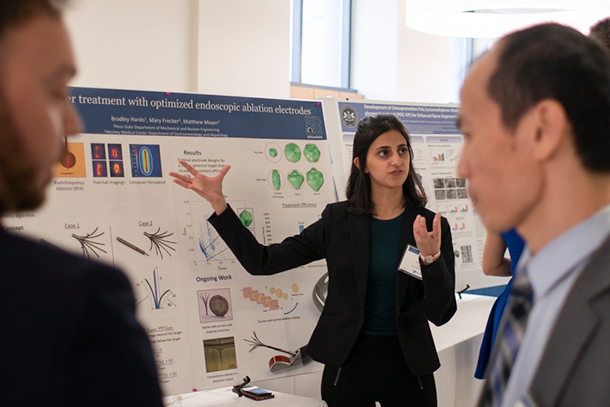
Fariha Azhar, an undergraduate student majoring in mechanical engineering, describes work developing endoscopic electrodes to help treat pancreatic cancer during the day’s research poster session and networking event.
Law, policy and engineering experts convene to address biodevice needs
4/12/19
UNIVERSITY PARK, Pa. – Experts from across the United States gathered at Penn State on April 11 to address the next generation of devices for biotechnology and biomedicine. It was the second event hosted under the Law, Policy and Engineering initiative. Jointly sponsored by the College of Engineering, Penn State Law, and the School of International Affairs, the initiative invites collaboration to address the profound challenges of humankind.
This symposium, which also was sponsored by the Penn State College of Medicine, and chaired by Andrew Zydney, the Bayard D. Kunkle Chair and professor of chemical engineering, brought together researchers and members of industry to discuss the potential legal ramifications, policy framework and technical know-how required to support and guide the accelerated advancement of biodevices.
“It’s by bringing together a wide range of expertise and wisdom that we can begin to find a new path forward and most effectively serve the Commonwealth and the world,” said Penn State President Eric Barron, in his welcoming remarks. He pointed to the breadth and depth of research at Penn State, which has more than $900 million in annual research expenditures.
“Given the complexity of the problems our world faces, it’s clear that we need collaboration, creativity, innovation
Humans have used technology interfaces for decades, with sensors and light signals. Interfacing has grown to interactions – a person can operate their home’s lights from across the world, just by asking their phone. Now, medical biodevices are growing more advanced and, with them, so are the questions surrounding the relationships people have with machines.
“Technology is a part of our lives. More and more, it’s becoming a part of us,” said Justin Schwartz, the Harold and Inge Marcus Dean of Engineering. “Implantable cardio devices help us live longer; artificial hips and knees, and spinal
Schwartz cautioned that the work is just beginning, reminding the audience that today’s commonplace technology was the stuff of science fiction just a decade ago. In another decade, it’ll be rudimentary, he said.
“Law and policy often struggle to appropriately regulate fast-moving science and technology,” said Hari Osofsky, dean of Penn State Law and the School of International Affairs. “Next-generation devices for biotechnology and biomedicine pose complex technological, ethical and legal issues and are an important example of why we need collaboration among, engineers, lawyers, and industry and public policy leaders. My hope is that today’s dialogue is just the beginning of a collaboration on these crucial issues, and I am excited about how we might build from here.”
Participants worked to identify and mitigate the roadblocks hindering efficient collaboration between the traditionally disparate groups. The day’s discussions were shaped by Greg Lucier, the chief executive officer of Corza Health, Inc., who gave the morning keynote. A panel discussion on facilitating the development of
After a networking poster session, participants broke into brainstorming sessions to discuss the particular challenges they face in developing biodevices, and the laws and policies surrounding them. The session was led by Mary Frecker, professor of mechanical engineering and biomedical engineering, and David Han, associate professor and vice chair for education, Department of Surgery, Penn State Heart and Vascular Institute, Penn State College of Medicine. The day concluded with the afternoon keynote address by Dan O’Connor, the president, director
“We brought together experts from across our disciplines to explore how biodevices could be the answer to the most fundamental challenges every person faces: the continuation of life, at the highest quality of life,” Schwartz said. “Today, we began the work of preparing to understand how law and policy will influence how we streamline our progress to enhance our lives, while still protecting human integrity.”


